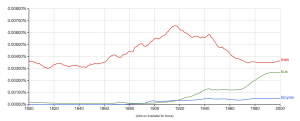I started my research with the idea of transportation in mind. I hoped to type in words such as train, bicycle, and bus to see the decrease of bicycle and increase of train and bus. There was in fact an increase in all three, but there was something I found on a website that interested me more.

(Graph of bicycle, bus, and train)
The modern bicycles was invented in 1885. It started out as a trending activity and then died out to become a method of cheap transportation for working class men. Bicycle riding started the revolution of women clothing. This revolution began with bloomers. In order for women to ride bicycles, they needed to wear pants instead of a dress. A woman, Amelia Bloomer, suggested that women would find these pants more comfortable than the petticoats they were wearing. Her unpopular suggestion that was published in The Lily, a feminist publication, did not become popular until after her death. In 1895, some women were wearing the bloomers and they became acceptable to wear if a woman was cycling.
The Google Ngram shows the relationship between the popularity of bicycles, bloomers, and petticoats over time. From 1890 to about 1900, bicycle made a huge climb and bloomers were also on the rise. Around 1900, petticoats dropped a significant amount and continued to decline years after that. In 1930, bloomers was at its peak. When selecting English Fiction as the setting, the Ngraph looked very similar to the English setting. When I selected British English as the setting, I noticed that the petticoat graph fluctuated between 1892 and 1851 more than the English setting.
As bicycles became more popular, as a method of transportation, and a way of staying healthy, women were interested in riding them. Traditional petticoats were heavy, long, and unsuitable for a task such as cycling. It is not surprising that as the popularity of bicycling increased, so did the popularity of bloomers. At a time of women revolting from their current status, being disrespected and treated unequally to men, this graph is interesting because it take a spin on the evolution of women in a Victorian Society. Could bicycles be a leading cause of women wanting equality and breaking free of their petticoats?
Sources
http://www.schoolsliaison.org.uk/kids/aston/changingtimes/victorian/transport.htm
http://www.fashion-era.com/rational_dress.htm
